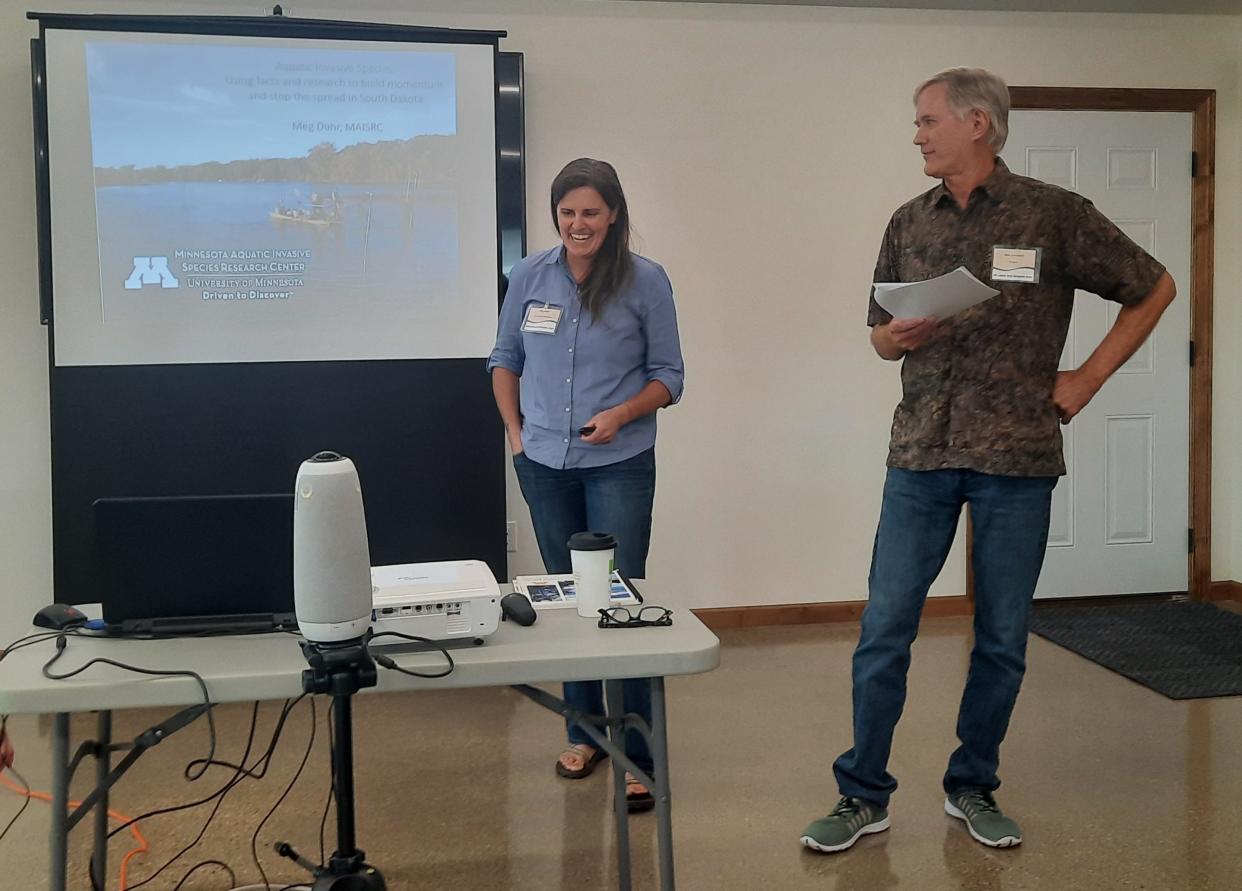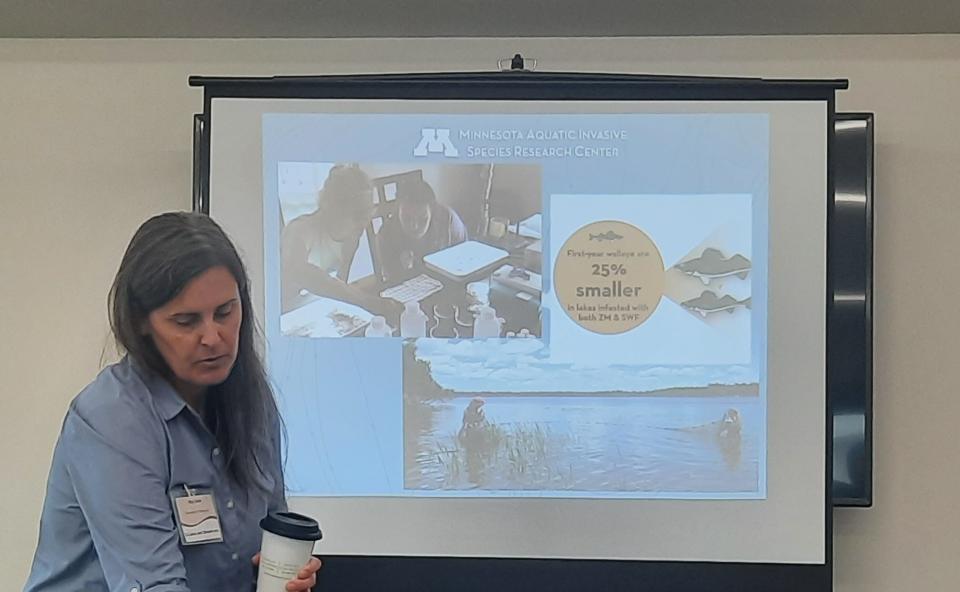South Dakota lakes and streams group seeks more help on zebra mussels shown to stunt walleye growth

Zebra mussels are steadily infesting South Dakota lakes, and the state’s walleye and perch populations likely are paying a price.
Not only are walleye smaller with less long-term survivability, but a current study also shows that zebra mussels increase the mercury content in walleye, said Meg Duhr, a research outreach specialist with the Minnesota Aquatic Invasive Species Research Center.
Duhr spoke recently at Pickerel Lake during a public forum about invasive species hosted by the newly reconstituted South Dakota Lakes and Streams Association. She delivered a host of bad news along with possible actions the grass roots group could take to raise awareness.
More: With boating season, these lakes are finding a way to stop the spread of zebra mussels
South Dakota Lakes and Streams Association President Dan Loveland, a Sioux Falls resident and Pickerel Lake property owner, said the coalition of lake representatives began forming last fall because they “felt they weren’t getting the type of attention that they needed” from state agencies in relation to invasive species.
The group has 14 lake associations as members and is recruiting more.
Zebra mussels discovered in South Dakota in 2015
Much discussion was focused on zebra mussels, which first were discovered in South Dakota in 2015 in the Lewis and Clark Reservoir. The invasive snail-like pests are now in 12 lakes, including Lake Kampeska, Lake Cochrane, Pickerel Lake and Enemy Swim Lake in northeastern South Dakota.
Other infested waters are Lewis and Clark Lake, McCook Lake, Yankton Lake, Lake Sharpe, Lake Francis Case, Dahme Quarry, Lake Mitchell and the Pactola Reservoir in the Black Hills.
Enemy Swim Lake probably shouldn’t be on the list as there is insufficient evidence of infestation and initial tests proved to be inaccurate, said board Vice President Steve Charron of Huron, who represents Enemy Swim Lake.
“This is not just about zebra mussels,” Loveland said. “There are other invasive species that are at least as bad or probably worse than zebra mussels. That is why we are here. We have a whole lineup of different kinds of invasive species that can just wreak havoc with our lakes and the economies around the area.”
Lakes and streams group wants more from GFP
The South Dakota Department Game, Fish and Parks is leading the state’s invasive species campaign, but the lakes and streams group wants a much stronger effort. The state lags far behind surrounding states, which all have much higher budgets.
Former State Sen. Deb Soholt of Sioux Falls, who represents Clear Lake in Marshall County, noted the state has no dedicated general fund money to combat invasive species.
More: Resolution encourages state to research zebra mussels, other invasive species in SD lakes
She shared GFP’s Aug. 1 report detailing its zebra mussel efforts during the past year.
The report was the result of a legislative resolution during this year's session “to strongly encourage that the executive branch of state government use all resources necessary to fight the spread of zebra mussels and other invasive species into our waters.”
GFP invasive species report 'disappointing' to some
Soholt said GFP’s report “is disappointing, not particularly useful and not forward-looking,” particularly since the legislature urged the agency to “use all resources necessary.”
Much GFP work in the past couple of years has been to inspect boats to ensure drain plugs are removed. Recreational boats are the primary spreaders of invasive species. Charron said that following the legislative decree, GFP’s inspection of boats in eastern South Dakota, where most lakes are, has actually decreased.
Inspections in western South Dakota are up, and GFP noted that it had “91-99% boat plug compliance at all locations in 2022.”
That means, Charron said, about 600 boats violated the law requiring plugs to be removed, yet only 40 citations and 60 warnings were issued based on a 95% average.
The board noted that some residents of infested lakes believe the zebra mussel invasion is beneficial because lake water is much clearer.
Lake environments changing because of invasive species
Duhr explained that “zebra mussels will have such a large-scale impact that they alter the physical structures of the lake.” That’s not good, she said, “Typically nonnative species are going to benefit from those things and native species will suffer because the whole environment of the lake is changing.”
More: Caron disappointed by zebra mussels discovery in Lake Kampeska
Her organization, based in St. Paul, Minn., is affiliated with the University of Minnesota and is doing wide-ranging research on many topics. Of most interest to anglers, and South Dakota's tourism industry, should be what's happening to walleyes.
2020 study shows walleyes getting smaller

A study published in January 2020 noted that walleyes in mussel-infested waters “were on average 12 or 14 percent smaller at the end of their first summer.” And in lakes where the invasive spiny flea also was found, they were 25% smaller.
The stunted growth is because zebra mussels consume phytoplankton and zooplankton that are important to young fish growth. The absence of those food sources forces walleye and perch to find alternative food sources.
“The water is clearer, which might be a good thing,” Duhr said. “But if water is not supposed to be clear, that can be really bad because more light enters the water, the water gets warmer and that drives plant growth.”
A new study is expected to show that zebra mussels also “make mercury more available to the walleye,” she said.
"We don't fully understand why zebra mussels seem to be connected to increased mercury levels in walleye, but one possibility is that all the zebra mussel excretion increases microbial activity at the bottom of lakes. This could be increasing the rate of mercury methylation, which makes it possible for mercury to enter the food web and become concentrated in predatory fish like walleye," Duhr said.
“It is pretty solid data, and we will share that in the fall," she said.
Can research yield ways to combat zebra mussels?
She also noted that extensive research might lead to a breakthrough in how to combat the invasive species.
Doing everything possible to stop the spread and buy time for researchers is critical, Durh explained.
“The longer you wait to act, the more widespread the invasive species becomes, becoming more costly and the less likely you are to be successful,” she said, adding that, “When you get a second (aquatic invasive species), it is much more unpredictable.”
More: Decline in freshwater mussels an indicator of poor river and stream health in South Dakota
That is why the South Dakota Lakes and Streams Association wants to work with GFP and other agencies to create a more effective campaign, Loveland said.
“We have to build some strategies,” he said. “We are all focused on the same objective. Let’s build a strategy on what want to do and how to do it.”
This article originally appeared on Aberdeen News: Growth of walleyes stunted by zebra mussels, 2020 study reveals

